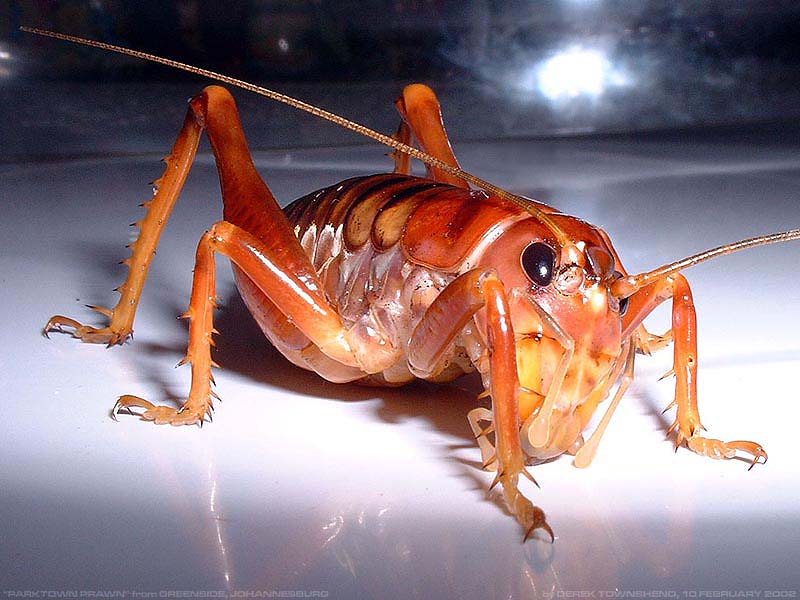- Parktown prawn
image_width = 250px
regnum =Animal ia
phylum =Arthropod a
classis =Insect a
ordo =Orthoptera
subordo =Ensifera
familia =Anostostomatidae
genus = "Libanasidus"
species = "L. vittatus"
binomial = "Libanasidus vittatus"
binomial_authority = W. F. Kirby, 1899Parktown prawn is the familiar term
South Africa ns use for "Libanasidus vittatus", a monotypicking cricket species found in South Africa, belonging to theAnostostomatidae family. It is not considered a true cricket. Adults are usually around 4 to 5centimetre s in length, with an antennae of 2 cm.Parktown is an affluent suburb inJohannesburg , where these crickets are commonly found, hence the name.History and discovery
The insect was not known within Johannesburg before the 1960s; the first known specimen being found in
Barberton in1899 byWilliam Forsell Kirby . They only became prevalent after 1960, when Johannesburg began to expand rapidly in size and population. The reason for the increase in the insects' numbers is not known, although they have flourished better in an urban environment than in the wild.Johannesburg, being part of the South African highveld, was almost totally dry and arid, which was unsuitable habitat for the Parktown prawn. With the arrival of suburban dwellers, gardens took on a more tropical and forest-like appearance, which was typically wet and well-covered, which helped the insect thrive. Johannesburg is considered to be the world's largest man-made forest, since the city is very green and leafy, representing a total transformation of local flora.
Appearance
The Parktown prawn is one of the larger insects found in Johannesburg homes. A large specimen may grow to be 10 cm or more, with long whip-like antennae extending to 5 cm. The exoskeleton is orange to light brown, with darker brown or black stripes along the
thorax andabdomen , which gives it a toxic look to would-be aggressors. The legs have downward-facing hooked barbs, which allow it climb up walls and trees.The male insect sports a strong set of
mandibles , although the need for them is not fully known, other than for use in self-defense against other male Parktown prawns. The female has a well-developedovipositor , through which it will lay between 80 and 100 eggs during mating season in damp or wet topsoil.Feeding habits
The Parktown prawn is typically omnivorous, feeding on
slug s,snail s andcutworm s as well as vegetable matter. They have been seen feeding on dog food, dead birds, as well as dry oatmeal and fallen fruit. They are also known to snack on wooden floor boards and wooden furniture. Gardens that have a high population of Parktown prawns will have almost no snails — thus, they can be considered an effective and natural form of pest control. Among their natural predators are theHadeda Ibis andHelmeted Guineafowl , two birds in the urban habitat that are able to take on the considerable size of the Parktown prawn.In society
They are generally considered pests by most in South Africa, and are held in the same regard as cockroaches. The strong
exoskeleton of the Parktown prawn makes it exceedingly difficult to kill. They are able to function for a short time when decapitated, and are less susceptible to insecticide than most otherarthropods Fact|date=February 2007. They are most visibly prevalent after rain during Summer, which is when they are most likely to be found indoors. Parktown prawns seem to be more active at night.The Parktown prawn is renowned and feared for its ability to jump long distances when threatened (they tend to jump towards you). They also release a vile-smelling black faecal liquid.
A popular urban legend, fuelled by
April Fools' Day articles published by the Johannesburg newspaper The Star, tells that the Parktown prawn was actually the result of an escaped genetic experiment by students from theUniversity of the Witwatersrand in the 1960s (thus explaining the insects' sudden arrival in Johannesburg at that time). The insect's unusual strength, vivid orange colouring and size are seen to 'confirm' this urban legend.Popular culture
The resilience and strength of the Parktown prawn allowed two
cartoon versions to become objects of humour in the well known South African cartoon stripMadam & Eve , inspiring fear in Gwen Anderson and Eve Sisulu. In the cartoons, the Parktown prawns get 'high' on insecticide (in reference to their size and how much poison is required to kill them), and produce two prawn-shaped indentations on the bottom of afrying pan with which they are swatted, in reference to their hard exoskeletons.In the 1980's
Andrew Buckland 's acclaimed play'The Revenge of the Ugly Nunus used Parktown Prawns as part of a extended parady of South African politics of the time.External links
* http://www.scienceinafrica.co.za/2003/november/monster.htm
Wikimedia Foundation. 2010.

